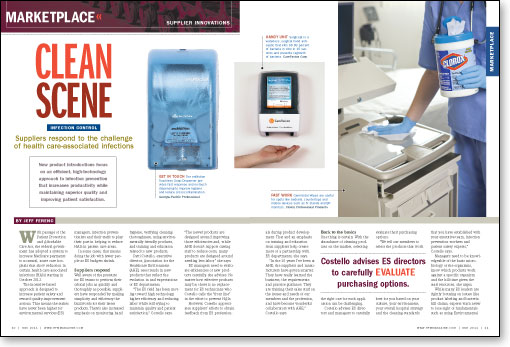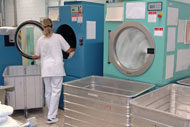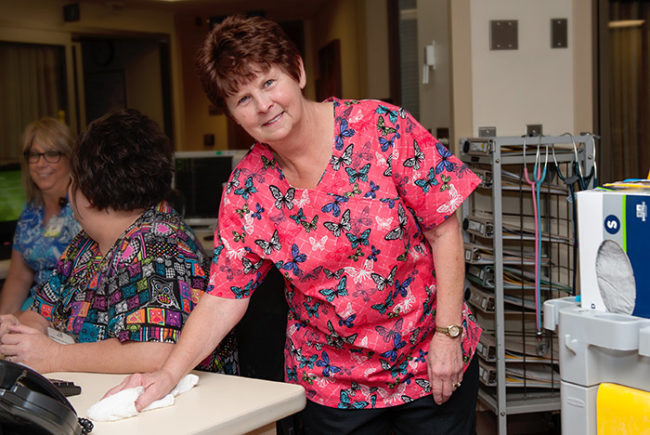
New product introductions focus on an efficient, high-technology approach to infection prevention that increases productivity while maintaining superior quality and improving patient satisfaction.
With passage of the Patient Protection and Affordable Care Act, the federal government has adopted a system to increase Medicare payments to nonrural, acute care hospitals that show reduction in certain health care-associated infections (HAIs) starting in October 2012.
The incentive-based approach is designed to increase patient safety and reward quality-improvement actions. That means the stakes have never been higher for environmental services (ES) managers, infection preventionists and their staffs to play their part in helping to reduce HAIs in patient care areas.
In some cases, that means doing the job with fewer people as ES budgets shrink.
Suppliers respond
Well aware of the pressure for ES teams to perform their critical jobs as quickly and thoroughly as possible, suppliers have responded by making simplicity and efficiency the buzzwords for their latest products. There's also increased emphasis on monitoring hand hygiene, verifying cleaning thoroughness, using environmentally friendly products, and training and education related to new products.
Patti Costello, executive director, Association for the Healthcare Environment (AHE), sees trends in new products that reflect the evolution in and expectations of ES departments.
"The ES field has been moving toward high technology, higher efficiency and reducing labor while still trying to maintain quality and patient satisfaction," Costello says. "The newer products are designed around improving those efficiencies and, while AHE doesn't support cutting staff to reduce costs, many products are designed around needing less labor," she says.
ES managers need to evaluate efficiencies of new products carefully, she advises. No matter how effective products may be, there is no replacement for ES technicians who Costello calls the "front line" in the effort to prevent HAIs.
However, Costello appreciates suppliers' efforts to obtain feedback from ES professionals during product development. That and an emphasis on training and education from suppliers help create more of a partnership with ES departments, she says.
"In the 10 years I've been at AHE, the suppliers and manufacturers have gotten smarter. They have really learned the business, the requirements and practice guidance. They are training their sales staff on the issues and needs of our members and the profession, and have become wonderful collaborators with AHE," Costello says.
Back to the basics
One thing is certain: With the abundance of cleaning products on the market, selecting the right one for each application can be challenging.
Costello advises ES directors and managers to carefully evaluate their purchasing options.
"We tell our members to select the products that work best for you based on your culture, your environment, your overall hospital strategy and the cleaning standards that you have established with your executive team, infection prevention workers and patient safety experts," Costello says.
Managers need to be knowledgeable of the basic microbiology of the organisms, know which products work against a specific organism and the kill time given the staff resources, she urges.
While many ES leaders are rightly focusing on issues like product labeling and bacteria kill claims, experts warn never to lose sight of fundamentals such as using Environmental Protection Agency-registered disinfectants and removing soil from surfaces.
Mike Weber, principal scientist at Procter & Gamble Professional (www.pgpro.com), Cincinnati, says cleaning is the first and most important step to achieving disinfection of any surface. "It doesn't seem that there's enough focus on the need to clean and remove soil, because soil is the medium that harbors bacterial germs," Weber says.
Procter & Gamble makes such products as Comet and Spic and Span that combine cleaning and disinfecting in one step to simplify the process for ES staff. The company also has simplified the cleaning process to reduce the number of products needed to get the job done.
"That's where our focus is now with our products. We have a simple lineup. You can clean the patient room with one or two of our products," Weber says.
Diversey Inc. (www.diversey.com), Sturtevant, Wis., is simplifying the disinfecting process by offering products that reduce the contact time for its surface disinfectants to three minutes or less. This offers several advantages, says Dale A. Grinstead, senior technical fellow, Diversey.
"Because it's a short contact time, it means it's easy to use," he says. "Focusing on best practices, easy-to-use products, ways to validate that the surface has been properly cleaned and disinfected — those are all part of the solution. There is no magic bullet for the process."
Streamlining the process
The Clorox Co., Oakland, Calif., is focusing on optimizing the cleaning process for ES teams by producing cost-effective products for multiple applications, says Hank Mercier, health care marketing manager, Clorox Professional Products division (www.cloroxprofessional.com).
"We're really focusing on how many pathogens we can kill, how quickly we kill them and that our disinfectants stay wet on the surface long to meet the kill times," Mercier says.
He agrees that ES departments want multipurpose — and fewer specialized — cleaning products that can kill as many viruses and bacteria as possible to streamline the process.
"ES managers will say, 'I don't want another specialized product on my cart because that's another thing my people are going to have to be trained on, to carry around, to order and to inventory,'" Mercier says. "There's a relentless drive to reduce the budget, to make it more efficient. The Holy Grail is one product that works for everything."
Clorox Germicidal Wipes are one of the company's responses to a hospital ES team's needs. The bleach wipes are made for daily disinfecting throughout hospital settings. The wipes kill a range of bacteria in 30 seconds and viruses in one minute, according to the manufacturer.
Linda Homan, manager of clinical and professional services, Ecolab Healthcare (www.ecolabhealthcare.com), St. Paul, Minn., says the company knows that effective cleaning of patient areas is critical in minimizing HAIs. While the job is frequently not done properly, studies show that establishing cleaning programs and processes significantly can improve cleaning quality, she says.
To address this issue and to meet recommendations outlined in the environmental hygiene-monitoring toolkit released by the Centers for Disease Control and Prevention (CDC), Ecolab offers the Encompass Environmental Hygiene program. Included are an array of cleaning tools, including microfiber mops and cloths, a range of liquid and spray disinfectants, germicidal wipes and more. Ecolab also offers program training.
Homan says another important trend in environmental hygiene is the push to evaluate the cleaning process by monitoring and measuring the thoroughness of cleaning. To that end, Ecolab offers the Dazo fluorescent marking gel, which leaves a clear mark on high-touch surfaces.
By shining an ultraviolet light over the scrubbed surfaces, the thoroughness of cleaning can be assessed. Data collected during this process can be sent to Ecolab through an iPod provided by the company, and then analyzed and reported to the hospital.
Hand hygiene still reigns
A 2008 study by the Association for Professionals in Infection Control and Epidemiology (APIC) determined that the rate of Clostridium difficile infections (CDI) in U.S. health care facilities rose to 13 per 1,000 patients, or up to 20 times higher than previously estimated. Based on this rate, it is estimated that there are at least 7,178 inpatients with CDI on any one day in U.S. health care facilities.
One of the best defenses against CDI and other common HAIs is continual and thorough hand hygiene. Even so, studies have shown an average hand-cleaning compliance rate of 40 percent for health care staff, says Charles Pigneri, director of global marketing, infection prevention-surgical products, CareFusion Corp. (www.carefusion.com), San Diego.
The CDC says poor hand-hygiene compliance is due to multiple factors, including perceived lack of time, and irritation or dryness caused by the continuous use of soap and water, according to Pigneri. To eliminate, or at least reduce, the discomfort and time factor related to multiple hand-washing events, CareFusion has added Surgicept Waterless Surgical Hand Scrub, Triseptin Water-Aided Surgical Hand Scrub, and Triseptin Hand and Body Antiseptic to its product portfolio.
Richard Melker, M.D., co-founder and chief technology officer, Xhale Innovations Inc. (www.xhale.com), Gainesville, Fla., knows the perils of staff not following a strict hand-cleaning regimen. With more than 50 percent of infections transmitted from patient to patient by health care workers' hands, the single biggest strategy to reduce infections is hand hygiene, he says.
The company makes HyGreen, which is designed to remind health care workers to wash their hands and monitor hand-hygiene compliance. After washing, health care workers place their hands under a sensor, which sends a wireless all-clean message to a badge worn by the worker.
A wireless monitor above the patient bed searches for the message and if it's absent, the badge vibrates to remind the worker to wash before patient contact. All interactions are logged in a database, providing an objective means of assessing hand hygiene by infection control staff.
Georgia Pacific Professional (www.gppro.com), Atlanta, offers a range of products intended to minimize or eliminate the need for health care staff to touch surfaces in bathrooms, where bacteria can thrive. Products include enMotion automated, touchless towel dispensers, soap dispensers and sanitizers, says Amy White, marketing manager, health care segment, Georgia Pacific Professional.
"By adopting best practices that govern hygiene and installing washroom technology that helps limit cross-contamination, health care facilities can reduce the incidence of dangerous infections," White says.
Jeff Ferenc is senior editor for Health Facilities Management magazine.
| Sidebar - For more information |
| For information on the carpeting products discussed in this month's "Marketplace," readers can contact the following manufacturers: CareFusion Corp. Clorox Professional Products Diversey Inc. Ecolab Healthcare Georgia Pacific Professional Procter & Gamble Professional Xhale Innovations Inc. |





